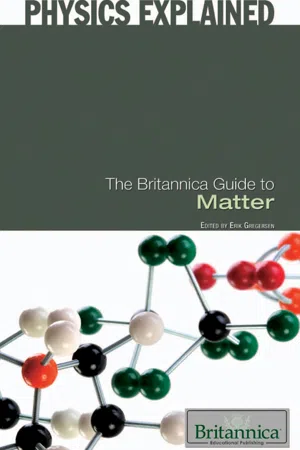Chemistry
Covalent Network Solid
A covalent network solid is a type of solid in which the atoms are bonded together by a network of covalent bonds, forming a continuous three-dimensional structure. This results in a strong and rigid solid with high melting and boiling points. Examples of covalent network solids include diamond, graphite, and silicon dioxide (quartz).
Written by Perlego with AI-assistance
Related key terms
Related key terms
1 of 4
Related key terms
1 of 3
7 Key excerpts on "Covalent Network Solid"
- eBook - ePub
- Jonathan W. Steed, Jerry L. Atwood(Authors)
- 2013(Publication Date)
- Wiley(Publisher)
metal-organic frameworks that exhibit remarkable structural robustness in comparison to traditional clathrates, yet are highly amenable to design and modification, in contrast to the inorganic zeolites. In reaching this point we have come on a long journey following the science of non-covalent interactions, from solution host–guest chemistry, which has been traditionally the preserve of synthetic organic chemists or coordination chemists, through the physical organic chemistry of clathrates all the way to what is really a branch of modern materials science. This breadth of supramolecular chemistry is at once one of its most daunting yet exciting features.For convenience we will classify network solids according to the dimensionality of their connectivity as listed below, where connectivity in this context refers to a strong covalent or coordination bond. Some examples are shown in Figure 9.1 .- 0D solids comprise discrete molecules – these are the kinds of compound we considered in the last chapter.
- ID solids comprise infinite thread-like strands. The solid is then made up of the non-covalent packing of these strands.
- 2D solids are made up of sheet-like components that are infinite in two dimensions and pack together via non-covalent interactions in the third.
- 3D solids are fully three-dimensionally interconnected covalent or coordination compounds in which the entire crystal is formally a single molecule.
Figure 9.1Schematic representation of some of the simple network architectures structurally characterised for metal-organic polymers: (a) 2D honeycomb, (b) ID ladder, (c) 3D octahedral, (d) 3D hexagonal diamondoid, (e) 2D square grid, and (f) 1D zigzag chain (reprinted from Section Key Reference © The American Chemical Society).Within these categories we will also distinguish between materials that are either porous or non-porous according to strict definitions that we will discuss in Section 9.1.3, and whether or not individual networks are interpenetrated (in one, two or three dimensions) with other networks – i.e . whether they are mutually topologically entangled in such a way that they could not be separated without breaking bonds. We begin with a description of nomenclature that we will use to describe network topology.9.1.2 Network Topology
Robson, R., ‘A net-based approach to coordination polymers’, J. Chem. Soc., Dalton Traits . 2000, 3735–3744.Topology is a basic field of mathematics in which any network is reduced to a series of nodes (connection points) and connections. Networks are said to be topologically equivalent unless they cannot be deformed into one another without cutting or glueing. Thus the topology of networks depends on the way in which they are connected, not on the shape or size of the individual components. The science of topology began with Leonhard Euler’s solution to the seven bridges of Königsberg problem. Königsberg (now Kaliningrad in Russia) was the capital of East Prussia and is built on the River Pregel at the junction with another river. The island of Kniephof is situated at the conflux of the two rivers. The island and different parts of the mainland are mutually linked by a total of seven bridges, Figure 9.2 - eBook - ePub
- Jeffrey Gaffney, Nancy Marley(Authors)
- 2017(Publication Date)
- Elsevier(Publisher)
Most molecular solids are soft, but can also be ductile or brittle. While brittle solids fracture immediately when enough stress is applied, ductile solids undergo a period of deformation followed by fracture. The intermolecular forces in many molecular solids are directional, leading to mechanical properties that vary with the direction of the applied stress. Molecular solids are usually insulators because the localization of electrons in the covalent bonds of the molecules prevents their movement in the crystal lattice. However, if an alkali metal is intercolated into the crystal lattice voids, the valence electrons on the alkali metal can be easily ionized allowing them to move freely in the crystal lattice. This gives the molecular solid electrical conductivity it would not otherwise have without significantly changing the other properties.11.4 Atomic Solids
Atomic solids , also called network solids, are composed of atoms connected by covalent bonds in a continuous network. There are two types of atomic solids: those that are totally composed of an extended three-dimensional covalent network and those that are composed of two-dimensional covalent networks, which are held together by weaker van der Waals forces (mixed bonding). In the three-dimensional networks, the covalent bonding extends throughout the solid and the result is a macroscopic interlocking covalent lattice structure. Any distortion of the crystal geometry can only occur through breaking the strong covalent bonds. In the two-dimensional networks, distortion of the three-dimensional geometry is more easily accomplished by disturbing the weaker intermolecular forces holding the two-dimensional planes together.The most common examples of atomic solids are the allotropes of carbon. These allotropes, different solid forms of carbon, are shown in Fig. 11.9 - No longer available |Learn more
- Neil D. Jespersen, Pamela Kerrigan(Authors)
- 2023(Publication Date)
- Barrons Educational Services(Publisher)
n-decanol has the structureCH3 CH2 CH2 CH2 CH2 CH2 CH2 CH2 CH2 CH2 OHThe long carbon chain is responsible for London forces, while the −OH at the end of the molecule provides hydrogen bonding.Network (Covalent) Crystals
A network crystal has a lattice structure in which the atoms are covalently bonded to each other. The result is that the crystal is one large molecule with a continuous network of covalent bonds. A diamond is pure carbon with each carbon atom covalently bonded to four other carbon atoms in a tetrahedral (sp3 ) geometry. The totality of this network of covalent bonds makes the diamond the hardest natural substance known. SiO2 is the empirical formula for sand and quartz. Silicon dioxide forms a covalent crystal with each silicon forming bonds to four oxygen atoms and each oxygen bonding to two silicon atoms with a tetrahedral geometry. Silicon carbide is another network crystal similar to diamond with alternating tetrahedral silicon and carbon atoms. It is very hard and is used as an industrial substitute for diamonds. Network crystals, like ionic substances, are represented by their empirical formulas.Graphite is another form (allotrope) of carbon in a covalent crystal. In graphite each carbon atom is covalently bonded to three other carbon atoms in a trigonal planar (sp2 ) geometry that gives graphite its structure of flat sheets. The extra p electron that is not used in the sp2 bonding holds these sheets together in a manner similar to that seen in a metallic crystal. The weak bonding of the p electrons allows the flat sheets to slide over each other easily and is responsible for the slippery feel of graphite. In addition, these p electrons are responsible for the ability of graphite to conduct electricity.Amorphous (Noncrystalline) Substances
Some materials are amorphous and do not form crystals. One characteristic of a noncrystalline substance is that it does not have a distinct, sharp melting point. Rather, these materials soften gradually over a large temperature range. Ordinary glass is an example. Although glass is composed mainly of SiO2 - eBook - ePub
- Britannica Educational Publishing, Erik Gregersen(Authors)
- 2010(Publication Date)
- Britannica Educational Publishing(Publisher)
Some molecules may exist in the liquid crystal state, which is intermediate to the crystalline solid and liquid states. Liquid crystals flow like liquids yet display a certain degree of the symmetry characteristic of crystalline solids.Four principal types of atomic bonds are found in crystalline solids: metallic, ionic, covalent, and molecular. Metals and their alloys are characterized in the main by their high electrical and thermal conductivity, which arise from the migration of free electrons; free electrons also influence how the atoms bond. Ionic crystals are aggregates of charged ions. These salts commonly exhibit ionic conductivity, which increases with temperature. Covalent crystals are hard, frequently brittle materials such as diamond, silicon, and silicon carbide. In the simpler, monatomic types (e.g., diamond), each atom is surrounded by a number of atoms equal to its valence. Molecular crystals are substances that have relatively weak intermolecular binding, such as dry ice (solidified carbon dioxide), solid forms of the rare gases (e.g., argon, krypton, and xenon), and crystals of numerous organic compounds.Various alloys, salts, covalent crystals, and molecular crystals that are good electrical insulators at low temperature become conductors at elevated temperatures, conductivity increasing rapidly with temperature. Materials of this type are called semiconductors. Their electrical conductivity is generally low when compared with that of such metals as copper, silver, or aluminum.BASIC UNITS OF SOLIDS
The definition of a solid appears obvious; a solid is generally thought of as being hard and firm. Upon inspection, however, the definition becomes less straightforward. A cube of butter, for example, is hard after being stored in a refrigerator and is clearly a solid. After remaining on the kitchen counter for a day, the same cube becomes quite soft, and it is unclear if the butter should still be considered a solid. Many crystals behave like butter in that they are hard at low temperatures but soft at higher temperatures. They are called solids at all temperatures below their melting point. A possible definition of a solid is an object that retains its shape if left undisturbed. The pertinent issue is how long the object keeps its shape. A highly viscous fluid retains its shape for an hour but not a year. A solid must keep its shape longer than that. - eBook - ePub
- Anthony R. West(Author)
- 2014(Publication Date)
- Wiley(Publisher)
3 Bonding in Solids 3.1 Overview: Ionic, Covalent, Metallic, van der Waals and Hydrogen Bonding in SolidsCrystalline materials exhibit the complete spectrum of bond types, ranging from ionic to covalent, van der Waals and metallic. Sometimes more than one type of bonding is present, as in salts of complex anions, e.g. Li2 SO4 , which have both ionic bonds between Li+ and SO4 2– ions and covalent bonds linking sulfur and oxygen atoms within SO4 2– ions. Commonly, the bonds are a blend of different types, as in TiO, which is ionic/metallic, and CdI2 , which is ionic/covalent/van der Waals. In discussing structures, it is often convenient to ignore temporarily the complexities of mixed bond types and to treat bonds as though they were purely ionic.Ionic bonding leads to structures with high symmetry in which the coordination numbers are as high as possible. In this way, the net electrostatic attractive force which holds crystals together (and hence the lattice energy) is maximised. Covalent bonding , by contrast, gives highly directional bonds in which atoms prefer a certain coordination environment, irrespective of other atoms that are present. The coordination numbers in covalent structures are usually small and may be less than those in ionic structures which contain similar-sized atoms.The bonding in a particular compound correlates fairly well with the position of the component atoms in the periodic table and, especially, with their electronegativity. Alkali and alkaline earth elements usually form ionic structures (Be is sometimes an exception), especially in combination with small electronegative anions such as O2− and F− . Covalent structures occur especially with (a) small atoms of high valency which, in the cationic state, would be highly polarising, e.g. B3+ , Si4+ , P5+ and S6+ and to a lesser extent with (b) large atoms which in the anionic state are highly polarisable, e.g. I− and S2− . Most non-molecular materials have mixed ionic and covalent bonding and, as discussed later, it is possible to assess the ionicity - eBook - ePub
- J Martin(Author)
- 2006(Publication Date)
- Woodhead Publishing(Publisher)
Part I Characterization of engineering materialsPassage contains an image
1Structure of engineering materials
1.1 Crystal structure
Crystal structure refers to the ordering of atoms into different crystalline arrangements. It is the arrangement of these atoms – the strength and directionality of the interatomic bonds – which determines the ultimate strength of the solid. Techniques involving X-ray or electron diffraction are employed to determine crystal structures, and four types of interatomic bonding are recognized: van der Waals, covalent, ionic and metallic. The latter three ‘primary’ bonds are limiting cases, however, and a whole range of intermediate bonding situations also exist in solids.The van der Waals force is a weak ‘secondary’ bond and it arises as a result of fluctuating charges in an atom. There will be additional forces if atoms or molecules have permanent dipoles as a result of the arrangement of charge inside them. In spite of their low strength, these forces can still be important in some solids; for example it is an important factor in determining the structure of many polymeric solids.Many common polymers consist of long molecular carbon chains with strong bonds joining the atoms in the chain, but with the relatively weak van der Waals bonds joining the chains to each other. Polymers with this structure are thermoplastic, i.e. they soften with increasing temperatures and are readily deformed, but on cooling they assume their original low-temperature properties and retain the shape into which they were formed.Covalent bonding is most simply exemplified by the molecules of the non-metallic elements hydrogen, carbon, nitrogen, oxygen and fluorine. The essential feature of a covalent bond is the sharing of electrons between atoms, enabling them to attain the stable configuration corresponding to a filled outermost electron shell. Thus, an atom with n electrons in that shell can bond with only 8 – n - eBook - ePub
Solid State Chemistry
An Introduction
- Elaine A. Moore, Lesley E. Smart(Authors)
- 2020(Publication Date)
- CRC Press(Publisher)
4 Solids Bonding and Electronic Properties Neil Allan 4.1 Introduction In Chapter 1, we introduced you to the physical structure of solids—the arrangement of their atoms and ions in space. We now turn to describe bonding in solids—their electronic structure. Some solids consist of molecules bound together by very weak forces. We shall not be concerned with these because their properties are essentially those of the individual molecules. In the final section we shall be concerned with ‘purely ionic’ solids bound by electrostatic forces between ions, as discussed in Chapter 1. The solids considered here are those in which all the atoms can be regarded as bound together. We shall be looking at basic theories of bonding in these solids and how they account for the very different electrical conductivities of different groups of solids—metals, insulators, and semiconductors. In particular we explain metallic bonding, a type of bonding not found in small molecules and clusters, and the high conductivities of metals. We shall cover a theory based on the free-electron model, a view of a solid as an array of ions held together by a ‘sea’ of electrons; and another theory based on molecular orbital theory, a crystal viewed as a giant molecule. Some of the most important solids are semiconductors. Many solid-state devices—transistors, photocells, light-emitting diodes (LEDs), solid-state lasers, and solar cells—are based on semiconductors. We introduce examples of some devices and explain how the properties of semiconductors make them suitable for these applications
Index pages curate the most relevant extracts from our library of academic textbooks. They’ve been created using an in-house natural language model (NLM), each adding context and meaning to key research topics.
Explore more topic indexes
Explore more topic indexes
1 of 6
Explore more topic indexes
1 of 4






